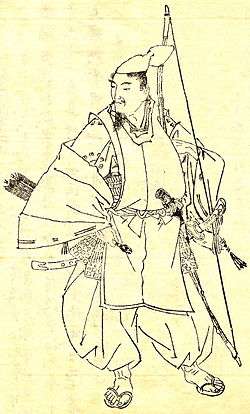Minamoto no Yorimitsu


Minamoto no Yorimitsu (源 頼光, 948 – August 29, 1021), also known as Minamoto no Raikō, served the regents of the Fujiwara clan along with his brother Yorinobu, taking the violent measures the Fujiwara were themselves unable to take. He is one of the earliest Minamoto of historical note for his military exploits, and is known for quelling the bandits of Ōeyama.
His loyal service earned him the governorships of Izu Province, Kozuke and a number of others in turn, as well as a number of other high government positions. Yorimitsu served as commander of a regiment of the Imperial Guard, and as a secretary in the Ministry of War. When his father Minamoto no Mitsunaka died, he inherited Settsu Province.[1]
Yorimitsu featured in a number of legends and tales, including the legend of Kintarō (Golden Boy aka Sakata no Kintoki), the legend of Shuten Dōji, and the legend of Tsuchigumo.
Raiko is usually accompanied by his four legendary retainers, known as the Shiten'ō (The Four Guardian Kings). They were Watanabe no Tsuna, Sakata no Kintoki, Urabe no Suetake, and Usui Sadamitsu.[2]
The Karatsu Kunchi festival in Karatsu City, Saga Prefecture, features a large float inspired by the helmet of Minamoto, being partially devoured by the oni Shuten Douji.
Poetry
Raiko wrote a renga with his wife, which appears in the Kin'yō Wakashū (nos.703-704):
tade karu fune no suguru narikeri
asa madaki kararo no oto no kikoyuru wa
This translates as:
a boat harvesting smartweed is passing by
I thought I heard someone rowing smartly before dawn[2]
See also
| Wikimedia Commons has media related to Minamoto no Yorimitsu. |
References
- Sansom, George (1958). 'A History of Japan to 1334'. Stanford, California: Stanford University Press.